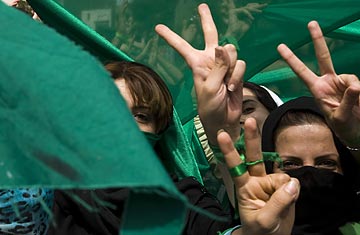
Supporters of defeated presidential candidate and opposition leader Mir-Hossein Mousavi show victory signs during a rally marking Qods (Jerusalem) Day in Tehran
It was easy to miss the most important development in Iran on Sept. 18: the fact that the much harassed opposition was still turning out immense crowds. For one thing, international media coverage had turned to the geopolitical intrigues of President Barack Obama's policy shifts on missile defense, signifying a possible new round of sanctions against Iran, coupled with signs of engagement that the U.S. would sit down with Iran for talks. President Mahmoud Ahmadinejad, sending his usual supply of mixed signals to the world, supports negotiations but is outwardly defiant on budging on Iran's nuclear policy, which Iran claims is for peaceful energy purposes. To make matters worse, Ahmadinejad took Friday to again question the Holocaust and also made a bizarre call for the breakup of Europe and even Russia into smaller nation-states — a statement that may leave Russia quite perplexed and anxious.
But it was the Iranian regime that was worried in the weeks leading up to what in Iran is known as Qods Day — the annual day of government-sanctioned rallies supporting Palestinian statehood that take place in most cities in Iran. All public events surrounding the Islamic month of Ramadan, which historically have provided opportunities for Iranian politicians from across the ideological spectrum to speak their minds, were either shut down or scaled back. Former President Mohammed Khatami was scheduled to speak alongside Ayatullah Ruhollah Khomeini's grandson at Khomeini's shrine two weeks ago, but the occasion was canceled. Former President Ali Akbar Hashemi Rafsanjani, who has delivered a Qods Day speech for decades, was replaced by a more hard-line Ayatullah who gave remarks in addition to an introduction by Ahmadinejad. And regime representatives including Supreme Leader Ayatullah Ali Khamenei had warned the Green Movement opposition against using Qods Day as an opportunity to protest the contested June election result and the harsh treatment of prisoners during the post-election crackdown. Yet the chief opposition representatives (Khatami, Mehdi Karoubi and Mir-Hossein Mousavi) all publicly called for Iranians to come out on the streets on Friday — not to protest against the lack of Palestinian rights but to protest against the lack of social and civil rights in Iran.
Few Iranians knew if there would be any turnout. It had been weeks since the last major opposition rallies, and in the meantime the public had been subjected to show trials, allegations of torture and rape in prisons and stern warnings by the regime against any future action. But as the world heard the erratic statements of Ahmadinejad set against the ongoing maneuvering of the U.S., Russia and China on sanctions vs. engagement, hundreds of thousands of green-clad opposition supporters in multiple cities in Iran defiantly took to the streets. Participants of the Qods Day protests told TIME that crowd sizes well equaled the large protests that took place in past months. Just as in previous demonstrations, old and young individuals from various social backgrounds attended the rallies, clashing with security forces and plainclothes Basiji militias and loudly voicing slogans during marches near the site of the President's speech at the University of Tehran's Friday prayers.
Two Qods Day rallies in Tehran had been planned — one starting from the northeast area of the prayer grounds and the other from the west. Soon after the second march began, its participants clashed with supporters of the President, but according to witnesses, the green demonstrators held their ground. In the first march, beginning in Haft-e Tir square in north-central Tehran, opposition marchers well outnumbered regime supporters. One participant told TIME that attacking security services had to retreat on multiple occasions due to organized resistance by the crowds, and eventually the police, in resignation, simply directed the march along its route. Once again, the Green Movement's supporters partly consisted of religious and poorer individuals, in addition to the more well-off protesters from north Tehran. One witness spoke of seeing an elderly chador-clad woman holding a large green banner prominently adorned with a picture of Ayatullah Khomeini — a sign that the Islamic Republic's founder is used as propaganda by supporters of both sides of Iran's post-election conflict.
With the opposition showing its strength even under pressure, it is questionable as to how much the Iranian regime's hard-line tactics have worked to demobilize the Green Movement's members. The rallies seem to be spontaneously organized through the Internet before trickling down to word-of-mouth notifications. Some participants said that future protests are already being planned, given the large and unexpected turnout on Friday. Due to Iran's many religious and revolutionary holidays, opposition supporters have no lack of opportunity to continue showing their protest against the regime. One of the next dates in sight: the 30th anniversary of the 1979 U.S. embassy occupation, on Nov. 4.
